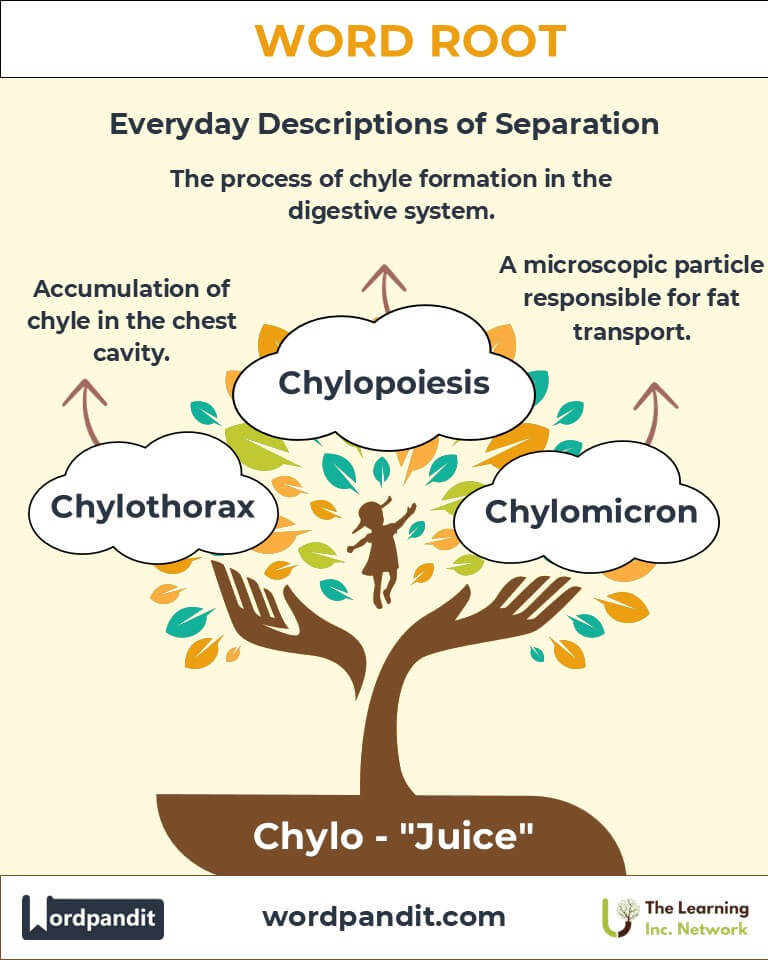Chylo: The Root of "Juice" in Language and Science
Dive into the fascinating world of the root "chylo," derived from the Greek word "chylos," meaning "juice." From its critical role in human biology to its presence in scientific terms like "chyle" and "chylomicron," this root captures the essence of nourishment and fluidity. Discover how "chylo" connects ancient Greek insights to modern biological science.

Table of Contents
- Introduction: The Essence of "Chylo"
- Etymology and Historical Journey
- Mnemonic: Unlocking the Power of Chylo
- Common Chylo-Related Terms
- Chylo Through Time
- Chylo in Specialized Fields
- Illustrative Story: Chylo in Action
- Cultural Significance of the Chylo Root
- The Chylo Family Tree
- FAQs about the Chylo Root
- Test Your Knowledge: Chylo Mastery Quiz
- Conclusion: The Living Legacy of Chylo
1. Introduction: The Essence of "Chylo"
When you think of "juice," it likely conjures images of fruit or vitality. In biological terms, the root "chylo" takes on a deeper meaning, representing life-sustaining fluids that fuel our bodies. Pronounced "KY-loh," this root is pivotal in terms like "chyle," a milky bodily fluid essential for nutrient absorption, and "chylomicron," a structure vital for fat transport. Understanding "chylo" opens a window into biology, connecting language with the science of sustenance.

2. Etymology and Historical Journey
The root "chylo" originates from the ancient Greek word chylos (juice), referring to any fluid extracted or expressed from a substance. Greek physicians, including Hippocrates, described "chylos" as the product of digestion. This term entered Latin and was later adopted into English, where it now signifies bodily fluids integral to digestion and nutrient transport.
Over centuries, "chylo" evolved into technical terms in biology, reflecting its Greek origins while adapting to modern scientific frameworks.
3. Mnemonic: Unlocking the Power of Chylo
To remember "chylo," picture a fresh orange being squeezed, its juice flowing out like the life-sustaining fluids in our bodies.
Mnemonic Device: "Chylo flows like juice, nourishing life through its roots in biology."
4. Common Chylo-Related Terms
- Chyle (KY-l): A milky bodily fluid composed of lymph and emulsified fats.
Example: "Chyle is transported by the lymphatic system after a meal rich in fats." - Chylomicron (KY-loh-MY-kron): A microscopic particle formed in the small intestine, responsible for fat transport.
Example: "Chylomicrons carry dietary lipids through the bloodstream." - Chylothorax (KY-loh-THOR-aks): A condition where chyle accumulates in the chest cavity.
Example: "The doctor diagnosed the patient with chylothorax after a chest injury." - Chylopoiesis (KY-loh-poi-EE-sis): The process of chyle formation in the digestive system.
Example: "Chylopoiesis is a critical step in lipid absorption."
5. Chylo Through Time
- Ancient Greece: Hippocrates and his contemporaries identified "chylos" as a key product of digestion, linking it to the body's ability to sustain itself.
- Middle Ages: As medical knowledge expanded, scholars incorporated "chylo" into Latin medical texts, emphasizing its role in nutrition and health.
- Modern Science: Today, "chylo" underpins terms in lymphatic research and clinical diagnoses, reflecting its enduring significance in understanding the human body.
6. Chylo in Specialized Fields
- Medicine: Chylothorax research addresses lymphatic disorders and trauma-related fluid accumulation.
- Nutrition: Chylomicrons explain how dietary fats are absorbed and utilized.
- Veterinary Science: Chyle analysis helps diagnose lymphatic issues in animals.
7. Illustrative Story: Chylo in Action
In a bustling hospital, Dr. Lin faced a puzzling case. A young patient complained of chest pain and difficulty breathing. Tests revealed chylothorax, an accumulation of chyle in the chest cavity. Using cutting-edge imaging and lymphatic interventions, Dr. Lin not only treated the condition but also educated the family on how the body's lymphatic system, powered by chylo, supports overall health. Her expertise underscored the profound role of "chylo" in medicine.
8. Cultural Significance of the Chylo Root
Though largely technical today, the root "chylo" symbolizes nourishment and sustenance across cultures. Ancient traditions often celebrated "juices" or life-giving fluids, connecting the root to broader themes of vitality and well-being.

9. The Chylo Family Tree
- Lymph- (Latin: "clear water"): Examples include "lymphatic" (related to the lymph system) and "lymphoma" (cancer of the lymphatic system).
- Juice- (Old English/Germanic): Examples include "juicy" (full of flavor or vitality) and "juiciness" (a metaphor for richness or abundance).
- Emuls- (Latin: "to milk out"): Examples include "emulsion" (a mixture of liquids) and "emulsify" (to blend liquids into a stable mixture).
11.FAQs About the Chylo Word Root
Q1: What does "chylo" mean?
A: "Chylo" means "juice" and comes from the Greek word chylos. It refers to life-sustaining fluids in the human body, such as chyle, which plays a central role in digestion and nutrient absorption. Historically, it symbolized nourishment and vitality.
Q2: What is chyle?
A: Chyle is a milky bodily fluid that contains lymph and emulsified fats. It forms in the small intestine during digestion, where dietary fats are absorbed and mixed with lymph. Chyle is transported through the lymphatic system and enters the bloodstream, providing essential nutrients.
Q3: What are chylomicrons?
A: Chylomicrons are tiny particles formed in the small intestine. They consist of fats and proteins and are responsible for transporting dietary lipids (fats, cholesterol, and fat-soluble vitamins) through the lymphatic system into the bloodstream, ensuring the body can utilize these nutrients effectively.
Q4: What causes chylothorax?
A: Chylothorax occurs when chyle leaks into the chest cavity due to trauma, surgery, or certain medical conditions like lymphoma. This condition can cause breathing difficulties and requires prompt medical intervention, such as drainage and dietary adjustments to reduce fat intake.
Q5: How is chylopoiesis significant?
A: Chylopoiesis refers to the process of forming chyle in the small intestine during digestion. It is crucial for fat absorption and transport. Any disruption in chylopoiesis can lead to malnutrition or impaired fat digestion, highlighting its essential role in maintaining health.
Q6: Is "chylo" used in contexts outside biology?
A: While primarily used in biology and medicine, "chylo" has metaphorical connections to nourishment and fluidity, symbolizing vitality and sustenance. For example, some literary references use "chylo" metaphorically to depict the essence of life or creativity.
Q7: What is the role of the lymphatic system in chyle transport?
A: The lymphatic system transports chyle from the small intestine to the bloodstream. It acts as a vital link in nutrient absorption, ensuring that dietary fats and fat-soluble vitamins are delivered efficiently to the body for energy and cellular functions.
12.Test Your Knowledge: Chylo Word Root Quiz
1. What does "chylo" signify?
2. What is chyle?
3. What do chylomicrons transport?
4. What condition involves chyle in the chest cavity?
5. Where is chyle formed?

12. Conclusion: The Living Legacy of Chylo
From its roots in ancient Greek medicine to its role in modern biological science, "chylo" symbolizes nourishment and the intricate workings of the human body. As our understanding of "chylo" deepens, its applications in medicine and nutrition expand, reminding us of the enduring power of this ancient root. Let "chylo" inspire your appreciation for the life-sustaining systems within us all.











